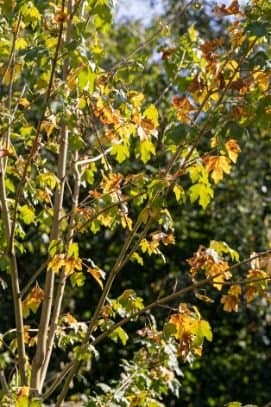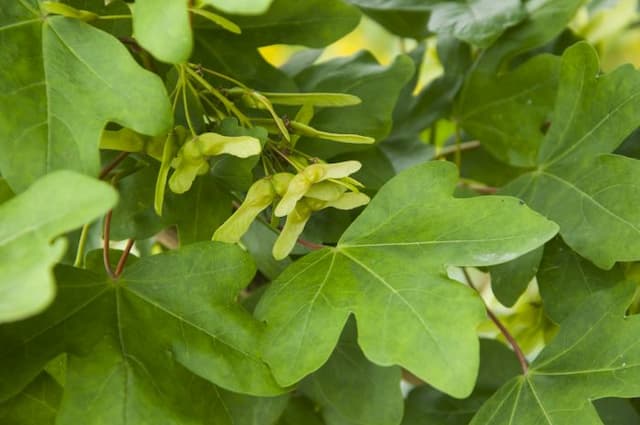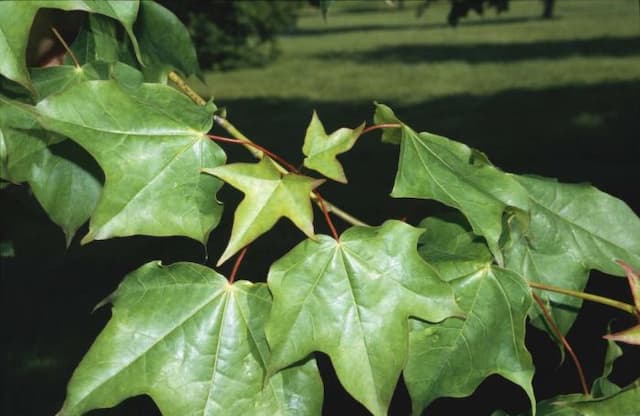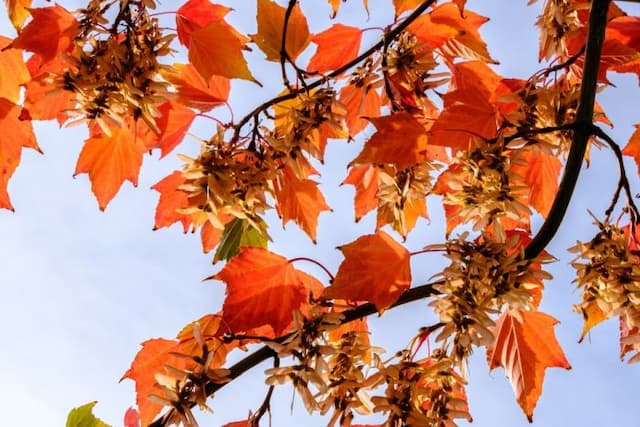Père David's Maple Acer davidii 'George Forrest'

ABOUT
Acer davidii 'George Forrest', commonly known as the George Forrest snakebark maple, is a visually striking plant with distinctive features. The bark of this maple is especially noteworthy, characterized by a greenish background crisscrossed by vertical white stripes, which gives the bark a snake-like appearance, hence the name "snakebark." The striations on the trunk and branches remain prominent throughout the year, adding to the plant's ornamental value. The leaves of the George Forrest snakebark maple are deciduous, meaning they shed seasonally. In shape, they are ovate with three distinct lobes, somewhat reminiscent of a classic maple leaf shape but with a more slender form. The foliage offers a sequence of colors throughout the seasons. In spring and summer, the leaves boast a lush green hue. With the arrival of autumn, they provide a vibrant display, changing to shades of red, orange, and yellow before falling off for the winter. This maple variety also produces flowers and samaras, which are its seed pods. The small flowers tend to be inconspicuous, blooming in subtle clusters. These give way to the samaras, which are winged and help the seeds disperse with the wind. When the samaras form, they add an extra layer of interest to the plant's aesthetic. Overall, the George Forrest snakebark maple is celebrated for its decorative bark, attractive foliage, and seasonal color changes. These characteristics make it a valued choice for ornamental landscapes, contributing to its visual appeal regardless of the season.
About this plant
 Names
NamesFamily
Sapindaceae
Synonyms
Père David's Maple, Father David's Maple
Common names
Acer davidii 'George Forrest'.
 Toxicity
ToxicityTo humans
The plant in question, commonly known as the George Forrest Maple, does not have a well-documented history of being toxic to humans. There are no common reports of poisoning or adverse effects from ingesting this plant. However, it is always advisable to exercise caution and avoid consuming parts of ornamental plants due to potential unknown risks or individual allergic reactions.
To pets
The George Forrest Maple is also not widely recognized as a toxic plant to pets. There is no specific information suggesting that ingestion of this plant by pets leads to poisoning. Nonetheless, pet owners should always be cautious and prevent pets from consuming plants not intended for dietary purposes, as individual animals might have different sensitivities or could experience gastrointestinal upset from ingesting plant material.
 Characteristics
CharacteristicsLife cycle
Perennials
Foliage type
Deciduous
Color of leaves
Green
Flower color
Yellow
Height
20 feet (6 meters)
Spread
15 feet (4.5 meters)
Plant type
Tree
Hardiness zones
6
Native area
China
Benefits
 General Benefits
General Benefits- Ornamental appeal: With its striking bark and vibrant foliage, Acer davidii 'George Forrest', commonly known as David's maple, adds aesthetic value to gardens and landscapes.
- Shade provision: The tree can offer a canopy of shade in gardens, providing a cool area during hot summer months.
- Habitat for wildlife: It can serve as a habitat and food source for birds and other wildlife, supporting local biodiversity.
- Seasonal interest: The David's maple has distinct seasonal changes that provide year-round interest in the garden, from spring blossoms to autumn leaf color.
- Low maintenance: It is generally easy to care for and does not require extensive maintenance, making it suitable for gardeners of all skill levels.
 Medical Properties
Medical PropertiesThis plant is not used for medical purposes.
 Air-purifying Qualities
Air-purifying QualitiesThis plant is not specifically known for air purifying qualities.
 Other Uses
Other Uses- Wildlife Habitat: Acer davidii 'George Forrest' can provide shelter and nesting sites for local bird species due to its dense foliage.
- Educational Tool: This plant can be used in educational programs to teach about botany, especially about patterns of leaf variegation and tree growth habits.
- Photography Subject: The unique striped bark and changing leaf colors throughout the seasons make the plant an attractive subject for nature photographers.
- Artistic Inspiration: Artists may use the Snakebark Maple's striking appearance as inspiration for various forms of art, such as painting and sculpture.
- Environmental Monitoring: As a bioindicator, the health and growth patterns of this tree can indicate the quality of the local environment and soil conditions.
- Seasonal Decoration: Its autumn foliage offers a natural and compostable option for seasonal decorations due to the leaves' vibrant colors.
- Cultural Symbolism: In some cultures, the maple may symbolize strength and endurance, and it can be planted to represent these qualities in landscaped areas.
- Woodworking Material: Although not commonly used for timber, the wood can be utilized for crafting small wooden objects or ornamental pieces.
- Boundary Marking: Acer davidii 'George Forrest' can be planted in a row to delineate property boundaries in a natural and aesthetically pleasing way.
- Hobby Gardening: This plant can be a prized specimen for hobbyist gardeners who specialize in cultivating rare or unusual trees.
Interesting Facts
 Feng Shui
Feng ShuiThe Snakebark Maple is not used in Feng Shui practice.
 Zodiac Sign Compitability
Zodiac Sign CompitabilityThe Snakebark Maple is not used in astrology practice.
 Plant Symbolism
Plant Symbolism- Resilience: Acer davidii 'George Forrest', commonly known as Snakebark Maple, often symbolizes resilience due to its ability to withstand different climates and grow in various conditions.
- Adaptability: This species reflects adaptability, mirroring its capacity to adapt to its environment, much like its ability to thrive in diverse natural habitats.
- Longevity: The long lifespan of the Snakebark Maple is seen as a symbol of longevity and endurance through the challenges of time.
- Growth: Symbolizing personal growth and development, Snakebark Maples, with their expansive growth, represent the journey of growing stronger and wiser through life's experiences.
- Beauty in Uniqueness: With their distinctively patterned bark, Snakebark Maples remind us to appreciate the beauty in uniqueness and the value of standing out.
 Water
WaterPère David's maple should be watered when the top inch of soil feels dry, usually once a week. During the growing season in spring and summer, water abundantly, ensuring the soil is moist but well-drained. Use about 1 to 2 gallons of water per watering session depending on the size and maturity of the tree. In the fall and winter, reduce watering as the tree's growth slows down. It's important to avoid waterlogging the soil to prevent root rot.
 Light
LightPère David's maple thrives best in partial to full sunlight. It should be planted in a spot where it receives at least 4 to 6 hours of direct sunlight daily. However, the plant appreciates some afternoon shade in hotter regions to prevent leaf scorch.
 Temperature
TemperaturePère David's maple prefers a temperate climate with temperatures ranging from 60°F to 80°F for optimal growth. These trees are hardy and can withstand a winter minimum of around -10°F. Frost damage is unlikely unless temperatures drop significantly below this.
 Pruning
PruningPrune Père David's maple to maintain its shape, remove dead or damaged branches, and encourage healthy growth. The best time for pruning is in late winter or early spring before the sap starts to flow. Prune sparingly and selectively, as heavy pruning can lead to excessive sap loss.
 Cleaning
CleaningAs needed
 Soil
SoilSnakebark Maple prefers well-draining soil rich in organic matter with a slightly acidic to neutral pH, between 5.5 and 7.0. A mix of loamy garden soil, compost, and perlite or pine bark can provide good structure and drainage.
 Repotting
RepottingSnakebark Maples should be repotted every 2 to 3 years or when they outgrow their current pot, usually in the spring before the onset of new growth.
 Humidity & Misting
Humidity & MistingSnakebark Maple thrives at moderate humidity levels, around 40-60%. It can tolerate some variation, but avoid placing it in an overly dry environment.
 Suitable locations
Suitable locationsIndoor
Place in bright indirect light, keep soil moist.
Outdoor
Full sun to partial shade, protect from harsh conditions.
Hardiness zone
6-9 USDA
 Life cycle
Life cycleGeorge Forrest Maple, like many deciduous trees, begins its life cycle with germination from a seed, typically in spring when soil temperatures warm sufficiently. The seedling stage follows, characterized by rapid root and shoot growth as it establishes itself. As the sapling matures into a young tree, it develops a stronger root system, a sturdier trunk, and branches that extend outward and upward. During its adult phase, the George Forrest Maple experiences seasonal cycles of growth, flowering, and seed production, usually flowering in spring with fruit maturing in summer or fall. Each year, the tree adds layers of growth to its trunk, expanding its diameter and height, and is capable of living for several decades. As it enters senescence, growth slows, and it may become more susceptible to diseases and environmental stresses before eventually dying.
 Propogation
PropogationPropogation time
Spring-Early Summer
Propogation: The most popular method of propagating the Acer davidii 'George Forrest', commonly known as the George Forrest's maple, is by seed. The best time to collect seeds is when they mature in fall. Fresh seeds should be sown in a cold frame as soon as they are ripe. Typically, one would mix the seeds with moist sand and store them in a refrigerator, at around 34 to 41 degrees Fahrenheit (1 to 5 degrees Celsius), for 90-120 days to stratify them, which breaks the dormancy and encourages germination. Once seeds have been stratified, they can be sown in a light potting mix, covering them with a thin layer of soil. It's essential to keep the soil moist but not waterlogged and to position the seed container in a spot with indirect sunlight. Seedlings usually emerge when the weather warms in spring.









